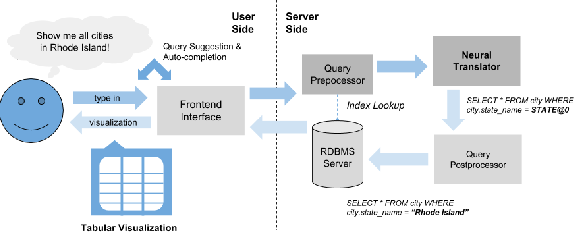DBPal
A DBPal is a Neural Natural Language Database Interface System that is based on a Deep Neural Network model.
- Context:
- It has been developed by Utama et al. (2018).
- It mainly consists of the following sub-systems:
- It has been evaluated by ParaphraseBench.
- …
- Counter-Example(s):
- See: Neural Semantic Parser, User Interface, Natural Language Processing, Natural Language Understanding, Natural Language Generation, Question Answering Task, NLQ, SQL.
References
2018a
- (Utama et al., 2018) ⇒ Prasetya Utama, Nathaniel Weir, Fuat Basik, Carsten Binnig, Ugur Cetintemel, Benjamin Hattasch, Amir Ilkhechi, Shekar Ramaswamy, and Arif Usta. (2018). “An End-to-end Neural Natural Language Interface for Databases.” In: CoRR Journal, abs/1804.00401. arXiv:1804.00401
- QUOTE: In this paper, we introduce DBPal, a relational database exploration tool that provides a robust and easy-to-use natural language (NL) interface with the purpose of improving the transparency of the underlying database schema and enhancing the expressiveness and flexibility of human-data-interaction. Different from existing approaches, DBPal leverages deep neural network models as the core of its natural language interface system.
(...) DBPal is the first system that allows users to build a robust NL-interface for a new database schema with only minimal manual annotation overhead. A screenshot of our prototype of DBPal, which implements the aforementioned features, is shown in Figure 1. We encourage readers to watch the video [1], which shows a recording of a representative user session with our system (...)

Figure 1: An Example Session in DBPal.
As shown in Figure 2, the DBPal system consists of two main components: a neural query translator and an interactive auto-completion feature to help users to phrase questions.

Figure 2: System Overview of DBPal.
- QUOTE: In this paper, we introduce DBPal, a relational database exploration tool that provides a robust and easy-to-use natural language (NL) interface with the purpose of improving the transparency of the underlying database schema and enhancing the expressiveness and flexibility of human-data-interaction. Different from existing approaches, DBPal leverages deep neural network models as the core of its natural language interface system.
2018b
- (Basik et al., 2018) ⇒ Fuat Basik, Benjamin Hättasch, Amir Ilkhechi, Arif Usta, Shekar Ramaswamy, Prasetya Utama, Nathaniel Weir, Carsten Binnig, and Ugur Cetintemel. (2018). “DBPal: A Learned NL-Interface for Databases.” In: Proceedings of the 2018 International Conference on Management of Data (SIGMOD 2018). ISBN:978-1-4503-4703-7 doi:10.1145/3183713.3193562
- QUOTE: DBPal leverages recent advances in deep models to make query understanding more robust in the following ways: First, DBPal uses novel machine translation models to translate natural language statements to SQL, making the translation process more robust to paraphrasing and linguistic variations. Second, to support the users in phrasing questions without knowing the database schema and the query features, DBPal provides a learned auto-completion model that suggests to users partial query extensions during query formulation and thus helps to write complex queries.